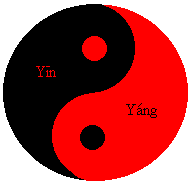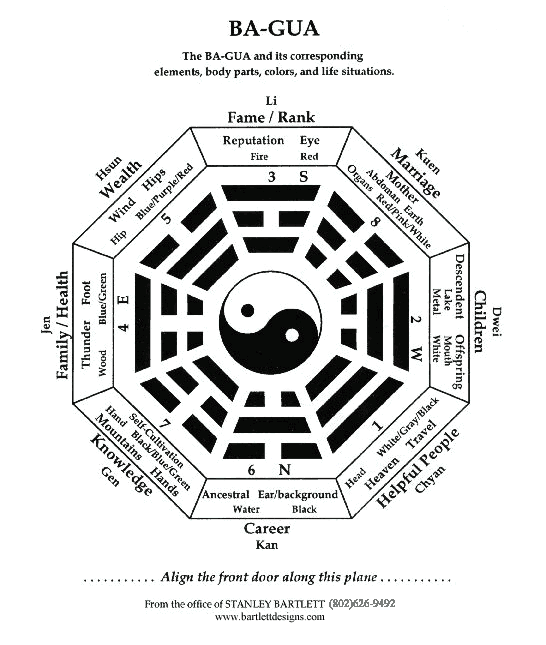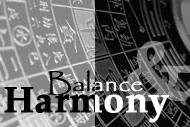Feng Shui was first used in China in the siting of graves.
It was important to site the graves of ancestors in good places that would
be unaffected by floods (water) and typhoons (wind). Feng Shui has
now become a very popular and practical design element in the western world.
Information about a specific site or room is gathered through sensing the
balance of yin and yang, and by using a feng shui compass. Traditionally,
yin is the dark, feminine, and receptive principle, and yang is the light,
masculine, and active principle. Together the yin and yang flow endlessly
into each other, and when balanced, can be appropriately applied to interior
spaces. A feng shui compass has an inner ring that is comprised of
eight trigrams (ba-gua). A trigram is a symbol made up of three stacked
lines, a solid line representing yang Ch’i, and a broken line representing
yin Ch’i. Creation of the eight trigrams is attributed to the legendary
Chinese king Fu Xi. He devised the eight trigrams through Taoist
observation of the natural world as seen on the patterns of a tortoise’s
shell as the animal emerged from the Yellow River. The eight tortoise
shell markings became the eight trigrams, which symbolize the natural world
as Heaven, Earth, Fire, Water, Lake, Mountain, Wind and Thunder.
Fu Xi laid out these eight symbols in an eight-sided map that became the
ba-gua, similar to a tortoise shell in shape. Each side of the eight-sided
map corresponds to one of the eight areas of life experience: career and
journey, knowledge and self-awareness, helpful people and travel, family
and health, children and creativity, wealth and prosperity, fame and reputation,
and relationships and marriage. By using the compass, the location
of each area of life experience can be determined.
 Taoist cosmology is structured on five natural elements: fire, earth, metal,
water, and wood. Everything on earth and in heaven is “characterized
by the constant interplay among the five elements, which are always moving,
unstable, and changeable, like the yin and yang” (Levitt, 21). In
Feng Shui, the balanced blend of all five elements creates a harmonious
environment. This is attained by applying the nurturing, controlling, and
reducing principles of the five elements. In the nurturing cycle
of the elements, fire nurtures earth because after fire burns it creates
more earth crust. Earth nurtures metal because metal ores are mined
from deep within the earth. Metal nurtures water because water is
contained and carried in metal vessels. Water nurtures fire because
adding wooden logs to a fire causes the fire to become bigger. Balance
is also achieved by applying the controlling element, in which fire controls
metal by melting it, and metal controls wood by cutting it. Wood,
in the form of trees, penetrates the earth and exerts an influence with
its roots. Earth controls the flow of water by blocking it with dikes
and dams, and water extinguishes fire. In the reducing cycle of elements,
fire burns wood, wood (trees’ roots) absorbs water, water corrodes metal,
metal is extracted from the earth, and earth suffocates fire. These
elements are allocated to different rooms in the home and to different
objects in order to facilitate the flow of the Ch’i.
Taoist cosmology is structured on five natural elements: fire, earth, metal,
water, and wood. Everything on earth and in heaven is “characterized
by the constant interplay among the five elements, which are always moving,
unstable, and changeable, like the yin and yang” (Levitt, 21). In
Feng Shui, the balanced blend of all five elements creates a harmonious
environment. This is attained by applying the nurturing, controlling, and
reducing principles of the five elements. In the nurturing cycle
of the elements, fire nurtures earth because after fire burns it creates
more earth crust. Earth nurtures metal because metal ores are mined
from deep within the earth. Metal nurtures water because water is
contained and carried in metal vessels. Water nurtures fire because
adding wooden logs to a fire causes the fire to become bigger. Balance
is also achieved by applying the controlling element, in which fire controls
metal by melting it, and metal controls wood by cutting it. Wood,
in the form of trees, penetrates the earth and exerts an influence with
its roots. Earth controls the flow of water by blocking it with dikes
and dams, and water extinguishes fire. In the reducing cycle of elements,
fire burns wood, wood (trees’ roots) absorbs water, water corrodes metal,
metal is extracted from the earth, and earth suffocates fire. These
elements are allocated to different rooms in the home and to different
objects in order to facilitate the flow of the Ch’i.
Another Feng Shui principle incorporates the
Chinese compass of north, south, east and west, in which south is located
on the top, and in the center of this compass is the “Middle Kingdom.”
The direction of south (summer) corresponds with warmth, heat, and vitality,
and its symbolic animal is the red phoenix, which represents beauty and
goodness. From the north (winter) comes cold snow and darkness, and
its symbolic animal is the black tortoise, which represents long life and
endurance. The direction east (spring), which is located on the left
side of the compass, corresponds to springtime, blue seas, and new growth.
Its symbolic animal is the azure dragon, which represents majesty and magnificence.
West (autumn) corresponds to snowy mountains, and its symbolic animal is
the white tiger, which exemplifies bravery and strength. These elements
are used for correct arrangement of furniture in rooms.
 The essence of Feng Shui is to analyze the landscape, house office, garden,
etc, and to determine where the most favorable flows of Ch’i are located,
and then to work out how to produce new Ch’i of enhance existing Ch’i concentrations.
Mirrors are the most common interior means by which Ch’i is enhanced and
adverse sha is deflected. Mirrors should be positioned in areas where
the flow of Ch’i comes to a dead end. Mirrors intended to enhance
the flow of Ch’i should be placed at an angle, so that the path of the
Ch’i is directed further along its way. Mirrors meant to counter
sha should reflect it straight back out of the house. Sound is another
way of deflecting sha. Wind chimes, running water, or any melodic,
pleasing sound are all effective ways to deflect sha. The presence
of anything living, such as birds, dogs, cats, and plants, helps to ward
off sha. Sha travels is straight lines, so straight objects such
as fishing rods, armrests of chairs, and bamboo poles can be positioned
in a way to repel sha. Anything that moves in a breeze, such as flags,
banners, mobiles, and wind chimes, activate and disperse lingering sha.
The smoke for burning incense and gently flowing water also disperse sha.
Objects that are beautiful and enhance a sense of stillness and serenity,
“such as a statue of Buddha, Kwan Yin (the Chinese goddess of compassion
and mercy), the Madonna, or even a piece of driftwood or a particular stone,”
can reverse intrusive sha (Sharp, 76).
The essence of Feng Shui is to analyze the landscape, house office, garden,
etc, and to determine where the most favorable flows of Ch’i are located,
and then to work out how to produce new Ch’i of enhance existing Ch’i concentrations.
Mirrors are the most common interior means by which Ch’i is enhanced and
adverse sha is deflected. Mirrors should be positioned in areas where
the flow of Ch’i comes to a dead end. Mirrors intended to enhance
the flow of Ch’i should be placed at an angle, so that the path of the
Ch’i is directed further along its way. Mirrors meant to counter
sha should reflect it straight back out of the house. Sound is another
way of deflecting sha. Wind chimes, running water, or any melodic,
pleasing sound are all effective ways to deflect sha. The presence
of anything living, such as birds, dogs, cats, and plants, helps to ward
off sha. Sha travels is straight lines, so straight objects such
as fishing rods, armrests of chairs, and bamboo poles can be positioned
in a way to repel sha. Anything that moves in a breeze, such as flags,
banners, mobiles, and wind chimes, activate and disperse lingering sha.
The smoke for burning incense and gently flowing water also disperse sha.
Objects that are beautiful and enhance a sense of stillness and serenity,
“such as a statue of Buddha, Kwan Yin (the Chinese goddess of compassion
and mercy), the Madonna, or even a piece of driftwood or a particular stone,”
can reverse intrusive sha (Sharp, 76).
|

 The principles of Feng Shui have existed for thousands of years.
Pictures of animals and symbols connected with feng shui have been found
which date back to prehistory. It has connections to many beliefs,
including Taoism, Confucianism, Buddhism, Shinto, and Vashtu Shastri.
The principles of Feng Shui are based on precepts laid down thousands of
years ago in the Chinese classics, particularly the Li Shu, or Book of
Rites, a sacred book that enshrines the basic tenets of Chinese religious
belief. It is concerned with order, the harmony of heaven and earth,
and with the ways in which humanity can best keep the balance of nature
intact. In the nineteenth century AD, Yang Yun-sung compiled the
first manual of Feng Shui, systematically describing the characteristics
of scenic formations. This book became the standard text of the Form
School of Feng Shui. About a century later, scholars living in the
flat plains of the north composed their own answer to the problems of analyzing
the Feng Shui of mountainless regions, compiling a guide to another system
of Feng Shui founded on the symbolism of the points of a compass, which
came to be known as The Compass School. Today, Feng Shui experts
combine the two systems, “looking first at the undulations of the surrounding
countryside, and then consulting the compass to note the alignments of
the surrounding mountains and rivers with the spot under consideration”
(Walters, 11).
The principles of Feng Shui have existed for thousands of years.
Pictures of animals and symbols connected with feng shui have been found
which date back to prehistory. It has connections to many beliefs,
including Taoism, Confucianism, Buddhism, Shinto, and Vashtu Shastri.
The principles of Feng Shui are based on precepts laid down thousands of
years ago in the Chinese classics, particularly the Li Shu, or Book of
Rites, a sacred book that enshrines the basic tenets of Chinese religious
belief. It is concerned with order, the harmony of heaven and earth,
and with the ways in which humanity can best keep the balance of nature
intact. In the nineteenth century AD, Yang Yun-sung compiled the
first manual of Feng Shui, systematically describing the characteristics
of scenic formations. This book became the standard text of the Form
School of Feng Shui. About a century later, scholars living in the
flat plains of the north composed their own answer to the problems of analyzing
the Feng Shui of mountainless regions, compiling a guide to another system
of Feng Shui founded on the symbolism of the points of a compass, which
came to be known as The Compass School. Today, Feng Shui experts
combine the two systems, “looking first at the undulations of the surrounding
countryside, and then consulting the compass to note the alignments of
the surrounding mountains and rivers with the spot under consideration”
(Walters, 11).
 Taoist cosmology is structured on five natural elements: fire, earth, metal,
water, and wood. Everything on earth and in heaven is “characterized
by the constant interplay among the five elements, which are always moving,
unstable, and changeable, like the yin and yang” (Levitt, 21). In
Feng Shui, the balanced blend of all five elements creates a harmonious
environment. This is attained by applying the nurturing, controlling, and
reducing principles of the five elements. In the nurturing cycle
of the elements, fire nurtures earth because after fire burns it creates
more earth crust. Earth nurtures metal because metal ores are mined
from deep within the earth. Metal nurtures water because water is
contained and carried in metal vessels. Water nurtures fire because
adding wooden logs to a fire causes the fire to become bigger. Balance
is also achieved by applying the controlling element, in which fire controls
metal by melting it, and metal controls wood by cutting it. Wood,
in the form of trees, penetrates the earth and exerts an influence with
its roots. Earth controls the flow of water by blocking it with dikes
and dams, and water extinguishes fire. In the reducing cycle of elements,
fire burns wood, wood (trees’ roots) absorbs water, water corrodes metal,
metal is extracted from the earth, and earth suffocates fire. These
elements are allocated to different rooms in the home and to different
objects in order to facilitate the flow of the Ch’i.
Taoist cosmology is structured on five natural elements: fire, earth, metal,
water, and wood. Everything on earth and in heaven is “characterized
by the constant interplay among the five elements, which are always moving,
unstable, and changeable, like the yin and yang” (Levitt, 21). In
Feng Shui, the balanced blend of all five elements creates a harmonious
environment. This is attained by applying the nurturing, controlling, and
reducing principles of the five elements. In the nurturing cycle
of the elements, fire nurtures earth because after fire burns it creates
more earth crust. Earth nurtures metal because metal ores are mined
from deep within the earth. Metal nurtures water because water is
contained and carried in metal vessels. Water nurtures fire because
adding wooden logs to a fire causes the fire to become bigger. Balance
is also achieved by applying the controlling element, in which fire controls
metal by melting it, and metal controls wood by cutting it. Wood,
in the form of trees, penetrates the earth and exerts an influence with
its roots. Earth controls the flow of water by blocking it with dikes
and dams, and water extinguishes fire. In the reducing cycle of elements,
fire burns wood, wood (trees’ roots) absorbs water, water corrodes metal,
metal is extracted from the earth, and earth suffocates fire. These
elements are allocated to different rooms in the home and to different
objects in order to facilitate the flow of the Ch’i.
 The essence of Feng Shui is to analyze the landscape, house office, garden,
etc, and to determine where the most favorable flows of Ch’i are located,
and then to work out how to produce new Ch’i of enhance existing Ch’i concentrations.
Mirrors are the most common interior means by which Ch’i is enhanced and
adverse sha is deflected. Mirrors should be positioned in areas where
the flow of Ch’i comes to a dead end. Mirrors intended to enhance
the flow of Ch’i should be placed at an angle, so that the path of the
Ch’i is directed further along its way. Mirrors meant to counter
sha should reflect it straight back out of the house. Sound is another
way of deflecting sha. Wind chimes, running water, or any melodic,
pleasing sound are all effective ways to deflect sha. The presence
of anything living, such as birds, dogs, cats, and plants, helps to ward
off sha. Sha travels is straight lines, so straight objects such
as fishing rods, armrests of chairs, and bamboo poles can be positioned
in a way to repel sha. Anything that moves in a breeze, such as flags,
banners, mobiles, and wind chimes, activate and disperse lingering sha.
The smoke for burning incense and gently flowing water also disperse sha.
Objects that are beautiful and enhance a sense of stillness and serenity,
“such as a statue of Buddha, Kwan Yin (the Chinese goddess of compassion
and mercy), the Madonna, or even a piece of driftwood or a particular stone,”
can reverse intrusive sha (Sharp, 76).
The essence of Feng Shui is to analyze the landscape, house office, garden,
etc, and to determine where the most favorable flows of Ch’i are located,
and then to work out how to produce new Ch’i of enhance existing Ch’i concentrations.
Mirrors are the most common interior means by which Ch’i is enhanced and
adverse sha is deflected. Mirrors should be positioned in areas where
the flow of Ch’i comes to a dead end. Mirrors intended to enhance
the flow of Ch’i should be placed at an angle, so that the path of the
Ch’i is directed further along its way. Mirrors meant to counter
sha should reflect it straight back out of the house. Sound is another
way of deflecting sha. Wind chimes, running water, or any melodic,
pleasing sound are all effective ways to deflect sha. The presence
of anything living, such as birds, dogs, cats, and plants, helps to ward
off sha. Sha travels is straight lines, so straight objects such
as fishing rods, armrests of chairs, and bamboo poles can be positioned
in a way to repel sha. Anything that moves in a breeze, such as flags,
banners, mobiles, and wind chimes, activate and disperse lingering sha.
The smoke for burning incense and gently flowing water also disperse sha.
Objects that are beautiful and enhance a sense of stillness and serenity,
“such as a statue of Buddha, Kwan Yin (the Chinese goddess of compassion
and mercy), the Madonna, or even a piece of driftwood or a particular stone,”
can reverse intrusive sha (Sharp, 76).